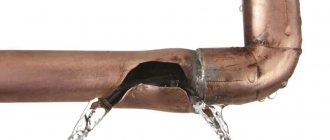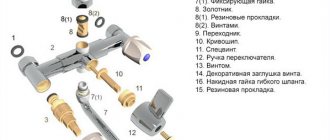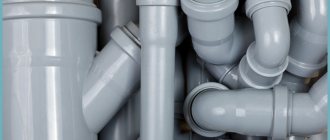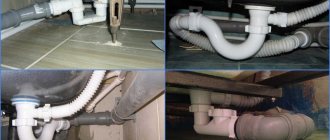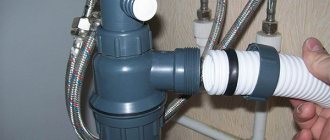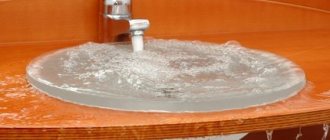Repair and decoration
04/17/2018 Anastasia Prozheva
Faulty plumbing is a big problem for every homeowner, but in most cases it can be successfully fixed.
Toilet drawing.
If the water in the toilet constantly flows, the flush does not work well, then this is a signal to take urgent measures to eliminate this malfunction.
After all, a leaking toilet brings with it high humidity, constant background noise, trouble with neighbors and high utility bills.
Possible causes of a toilet leaking from below - we carry out diagnostics
Even if the water is only leaking a little, the problem cannot be ignored. Such a defect means not only constant dampness in the bathroom, but also the danger of a more serious leak, which can happen at any moment. And this can result not only in a large water bill, but also in repairs for the neighbors below.
Let's understand the problem:
- To get started, arm yourself with a flashlight and a paper towel.
- Carefully inspect the toilet bowl, base, socket, hose, and connections. If you can't see it with your eyes, apply a paper towel; wet spots will become an indicator.
What an inspection can show:
- Damage to the toilet itself (in its faience part).
- Joints, connection points (pipe with toilet, flexible hose or tank with inlet fittings, bowl and tank, etc.).
Once you understand where the water is leaking, you need to understand whether you can solve the problem yourself.
Connection of inlet fittings and hose
To carry out the procedure, you will need a hose or gasket and a regular adjustable wrench. The repair procedure includes the following steps:
- Using an adjustable wrench, tighten the nut that may not have been fully tightened when installing the hose (do not use excessive force, as you may break the device).
- Check the gasket, if it is damaged or just old, then you need to install a new one. To do this, you need to turn off the water supply, unscrew the flexible hose and install a new gasket.
- If the hose is cracked, then it also needs to be replaced, giving preference to expensive and high-quality products.
Crack in faience
So, water is dripping from cracks in the toilet itself. They arise for various reasons. It happens that the product is not carefully transported to the buyer. If the toilet received a “wound” on a bumpy road and it is small, then initially, when it has not yet been used, it will not be noticeable. The crack will appear as it gets dirty and will become more noticeable. If the damage is in a place that is hidden from view, then you may not be aware of its existence, but over time it may begin to leak water.
Another reason for damage to earthenware can be a sudden change in temperature. When boiling water is poured into the toilet, when it comes into contact with hot steam (careless treatment with a steam generator, etc.).
The first thought is that we need to run for a new toilet. But you can try to revive the old one. In any case, it will be cheaper than a new earthenware product. The only inconvenience is that you need to figure out how your family will live without a bathroom for a day.
What you need to have:
- Sandpaper of different grits.
- Epoxy resin based adhesive (two-component).
- Hair dryer.
To restore the integrity of a damaged sewer section, you need to:
- Turn off the water supply to the tank, remove moisture from the surface near the crack and dry it thoroughly with a hairdryer.
- Thoroughly clean the damaged area with medium-grit sandpaper. We want this area to become rough and create a small depression.
- Dilute the glue, strictly following the instructions.
- Apply a thin layer of adhesive mixture to the damage. When the entire crack is filled with glue, leave it to dry for a day.
- After 24 hours, clean the treated area with fine sandpaper and remove any unevenness.
Now you can use the toilet, it should not leak if that was the reason.
How does a toilet work?
There are many varieties of this plumbing fixture. There are suspended and floor-mounted structures. The first ones are fixed to a special installation hidden in the wall. The second ones are installed on the floor. Regardless of this, each toilet has three main elements.
The largest structural element is the bowl . It usually has the shape of a vessel of the same name, which is why it got its name. The open part of the part gradually turns into a siphon. This is the name of a curved channel, which in working condition is filled with water.
Its diameter and bending shape are calculated in such a way as to allow the required amount of waste to pass through without hindrance. A water seal is formed in the siphon, protecting the room from unpleasant odors.
Structurally, toilets can differ significantly from each other, but the basic elements are always present
The reservoir in which the water intended for flushing is placed is called a cistern . May have a different design and type of liner. It is most often made of ceramic, but can be plastic or metal.
The main elements of the tank can be considered drain fittings, a fill valve, a drain and overflow mechanism. The drain mechanism is activated by pressing a button or lever, this depends on the tank model.
Image gallery
Photo from
Flush tank - a functional container with water
Seal around drain hole
Seal at the water supply connection
Damaged float mechanism
The parts designed to ensure maximum comfort when using the toilet are the seat and the lid. Most often it is made from various plastics; there are models made of wood or soft versions covered with foam rubber. You can also find functional seats. For example, bidet attachments are built into them.
The tightness of joints and places where parts are connected is broken
Checking the tightness of the joints is something that can be done when looking for the cause of the problem. There are several such connection points.
The junction of the bowl and the tank
- The steel fasteners are rusty. To correct the current problem and eliminate a similar one in the future, you need to cut them off with a hacksaw and replace them with other fasteners without galvanization.
- The fastening of the connecting screws is loose, which often occurs if you lean your back on the tank. Accordingly, the problem is solved by tightening the fasteners, for which a special key is used.
- Improper installation of the gasket or the natural process of wear of the rubber material is another reason why a leak occurred. The connection must be unscrewed, the position and integrity of the gasket checked, and if necessary, replaced with a new one.
The junction of the inlet fittings and the tank
The water supply can be bottom or side:
- The first thing to do if the inlet fitting is attached using the bottom connection technology is to tighten the nut with a suitable size wrench. Perhaps the only reason is that due to the gasket not fitting tightly enough, puddles appear near the toilet. If this does not help, then you need to check the gasket at the junction of the tank and the fittings for integrity. To do this, unscrew the nut, remove the flexible hose and inspect the gasket. Its clearly worn and worn condition is the reason for installing a new element.
- With a side connection, the reason may be slightly different, namely incorrect operation of the shut-off valve. As a result of such a failure, the water level inside the tank exceeds the maximum mark, and water leaks onto the floor. The problem is solved by adjusting the position of the float; it must be lowered a little lower by tightening a special screw. At the same time, you can check the condition of the gasket and diaphragm valve. The first is replaced as it wears out, and if the second is faulty, all shut-off valves are replaced.
Joint between inlet fittings and hose
- To fix the problem, you need to turn off the water and use a wrench (or adjustable) to unscrew the joint.
- After disconnecting the flexible hose, check the condition of the gasket. If necessary, replace it with a new one.
- Check the flexible hose itself. Perhaps there are cracks on it, which lead to water leakage. In this case, you will have to replace the hose itself.
- After reassembling everything, tighten the nut thoroughly, but do not overdo it, otherwise you will damage the threads.
A sign of a broken toilet is leaking water.
Proper flushing occurs when liquid enters the toilet bowl briefly or over longer periods of time, flushing it completely. Washing begins when you press the flush button with your hand. The flow of water into the bowl stops after pressing the button. Some toilet models require pressing again. Instead of a button, there may be a lever or a drain handle on a chain.
The flushing process begins and ends only from user actions. The drain button is connected to the drain valve. Then the chain stretches to the locking mechanism. After washing the bowl with water, the locking mechanism allows a new portion of liquid to flow into the drain tank from the water supply.
It is worth thinking about checking the integrity of the tank parts if water constantly flows along the walls of the toilet bowl or you can hear periodic flushing of water without pressing the flush button.
Knowing the structure of the trigger mechanism, you can carry out repairs yourself.
You can talk about the presence of a leak during flushing if the following facts are observed:
- the gurgling of liquid from the toilet is constantly heard;
- traces of rust are noticeable in places where liquid is drained into the bowl;
- if, after prolonged inactivity, wet marks are visible on the walls of the toilet;
- washing takes longer and slower;
- when the tank and nearby pipeline pipes become covered with condensate;
- There's wetness on the floor.
The work begins with inspecting the walls of the cistern. The reason for the appearance of limescale stains on the walls of the bowl may be dirt on the fittings of the cistern and its walls. Therefore, cleaning the walls and fittings with cleaning agents to remove dirt deposits will eliminate the problem of smudges. The liquid drains from the tank and its flow stops. The internal walls of the tank are being cleaned.
Leaking corrugations on the toilet
- There is no rubber sealing ring - it is either worn out and does not perform its functions, or they simply forgot to install it when installing the bowl. Once you add this part, the toilet will function normally.
- A crack in the corrugation itself. Only replacing the part with a new one will help here.
- No transition cuff. This reason only applies to toilets connected to cast iron sewer pipes. Without an adapter, it will not be possible to achieve a high degree of sealing, which is a prerequisite for installing a toilet. To do everything efficiently, place the adapter cuff on silicone sealant and coat all joints with it.
Leaks under the tank
Why does the toilet leak from under the tank?
Reason 1
A cuff in the shape of a truncated cone is placed between the separate shelf and the toilet. Over time, it loses elasticity, cracks and leaks.
Solution 1
If the cuff is relatively new, tighten it at the release with thick copper wire.
If the cuff is cracked due to age, only replacing it will help. In the store, choose the softest and most elastic of all offered.
Tip: it is easier to pull the cuff into place after first holding it in hot water.
When looking at this connection between the shelf and the toilet, anger and hatred begin to boil in any experienced plumber.
Reason 2
There is also a rubber cuff between the monolithic toilet shelf and the cistern, which can leak if the bolts are loosely or unevenly tightened (see also the article on repairing a toilet cistern).
Solution 2
- Turn off the water to the tank and rinse;
- Unscrew the bolts so that the nuts rotate without force. If you immediately start tightening the bolt that is already tightened tighter, the distortion can split the tank.
- Tighten both bolts by hand with exactly the same force.
- Next, using pliers or an adjustable wrench, tighten them strictly symmetrically, avoiding great force.
And this cuff can leak if the bolts are not tightened evenly.
Reason 3
The gaskets under the heads of the bolts that attract the toilet to the shelf are not pressed. Alternatively, the bolts have burst or rusted.
Solution 3
- Inspect the tank and shelf inside and out. Check if the bolts themselves are intact.
- If they are steel and heavily rusted, just replace them; if at least one of them bursts, both change.
- If the bolts are made of brass, plastic or stainless steel and are not damaged, carefully tighten them after shutting off and draining the water.
- If necessary, change the gaskets under the caps. They are sold in any plumbing store as part of countless sets of gaskets for different devices. You don't need to look for exactly the same ones - rubber is elastic, don't forget.
- New bolts must match the length and diameter of the old ones and be made strictly of stainless material.
Steel bolts are removed from the tank like this.
- When tightening the bolts, avoid distortions and great force.
The junction of the pipe and the bowl outlet
If the joint in this place is leaky, then it is worth re-treating it with sealant. But first you will have to turn off the water, dismantle the toilet, remove the old sealant from the joint with a screwdriver or chisel, put everything back in place and apply fresh silicone sealant all around.
Important! After this, you cannot use the toilet for a day; you need to let the sealant completely harden.
Check that the toilet is securely fastened to the floor, tighten and, if necessary, secure the fasteners.
Important! If the base of the toilet is cracked, it will have to be replaced. The repair will not have the desired effect.
The cuff or corrugation is worn out
The rubber gasket became less elastic over time and cracked. To fix the problem, you need to remove the toilet from the base. Remove the old cuff. Install a new cuff on the sealant. If it is not possible to buy a new gasket, then the old gasket is bent upward around the circumference and sealant is thickly applied into the resulting space. Most problems can be solved with sealant, glue or a new gasket. In the most severe cases, you need to buy a new toilet and call a specialist to install it.
Some tips for the future
- Periodically check the areas behind the toilet and joints for moisture. Sometimes it can ooze out completely unnoticed. There will be no puddles, but brown streaks will be visible. These are the “first signs” and they cannot be ignored, since a large leak can occur at any inopportune moment.
- Every few years, check the condition of the gaskets and replace them with new ones if they are already outdated. Don't wait until the parts fail completely.
- Try not to lean on the tank while sitting on the toilet; press the flush buttons carefully.
- Special water filters will help prevent premature wear of fittings. This way, foreign impurities will not get into the tank, which will undermine the metal and clog the space between the moving elements.
- When replacing gaskets and other parts, do not skimp and buy from reliable manufacturers. This is a guarantee of long service life for your plumbing fixtures.
Having understood such an unpleasant phenomenon, we can draw the following conclusion:
- Minor defects such as wear of individual elements, which can be reached without complex disassembly of the entire system, can be repaired independently. Anyone with “hands in the right place” can do this.
- If there are serious cracks in the thicket or at its base and you definitely need to reinstall the plumbing with new ones, then decide what to do based on your experience. If it is not there, it is still better to entrust this work to a professional.
Share on social media networks:
How to prevent it in the future
A leak in the toilet brings with it high humidity, constant background noise, troubles with neighbors and high utility bills.
In order to use your plumbing for a long time and not have to resort to constant repairs, you should:
- periodically check all joints and connections, as well as the condition of pipes and rubber seals;
- use flush levers and buttons carefully, avoid sudden pressure;
- it is recommended to install cleaning filters to prevent unnecessary impurities and particles from entering the drain tank and clogging the system;
- choose high-quality components when replacing failed toilet elements.
Purchasing plumbing fixtures from reliable manufacturers, timely periodic inspection of the drainage system and parts, as well as seeking the help of professional plumbing service workers will save you from such a nuisance as a leaking toilet.
Conclusions and recommendations for repairing the toilet installation
Independent repair of built-in toilets is possible if you understand the principle of operation of the fittings and are familiar with the purpose of the components. You can buy spare parts for installation models from different manufacturers - complete drain/fill fittings, O-rings, rocker blocks, key pushers, single- and dual-mode flush buttons, frames, flexible hoses in our Aquasliv online store.
If you have no experience in servicing plumbing, it is better to resort to the services of a specialist. A master plumber will help you solve problems with the installation of any wall-hung toilet, including the bidet function.
Leave a request for a technician to visit you within the Moscow Ring Road for free
See also:
Grohe installation repair
Geberit installation repair
Wisa installation repair
Repair of Cersanit installation
Removing Geberit tank fittings
Using the Geberit with mechanical control as an example, let's look at the sequence of the disassembly process. First, be sure to turn off the water supply to the bathroom and empty the tank by pressing the release! Then you need to:
- Remove the flush button: lightly press the panel from bottom to top to disengage. Check out the explanatory pictures on the partition.
Remove the button. - Remove the pushers: turn, pull towards you.
Pushers
Removable with a twist. - Turn the side clamps or unscrew the two screws securing the frame and remove the frame.
Rotatable side clamps.
Screw mounting option. - Remove the partition by pressing the latches.
We dismantle the partition. - Remove the rocker arm assembly.
Remove the rocker block. - Close the valve inside the tank.
We close the valve. - Unscrew the union nut and disconnect the supply hose.
Disconnect the supply hose. - Remove the filler block.
Remove the filler block. - Perform partial disassembly for cleaning and washing.
We disassemble and wash the block. - Remove the drain valve bracket by moving the upper hooks apart (the fastening design differs for different brands).
Remove the drain valve mount. - Remove the bottom valve in parts: holding the bottom of the flask, turn the upper element until the bayonet connection disengages; snap off the small flush rod and turn it to the bottom.
Bayonet connection.
Released small flush rod (white) and bracket (black).
Video instructions:
Main causes of urinary incontinence
Periodic or constant leakage of urine is a purely female problem. Men encounter this pathology much less frequently. Most often, signs of incontinence are recorded in women who have given birth.
, and the greater the number of births, the more likely the occurrence of the disease. The main cause of incontinence is disruption and weakness in the muscles that support the pelvic organs. There is also often a change in the functioning of the sphincters of the urethra and the bladder itself.
Most often, signs of incontinence are recorded in women who have given birth, and the greater the number of births, the more likely the occurrence of the disease. The risk of urine leakage increases many times if:
- labor was protracted or, on the contrary, rapid;
- the birth of a child was not without ruptures of the pelvic floor muscles.
Determining the underlying cause of urinary incontinence is necessary to determine the most effective treatment option. Women should remember that modern medicine can solve their problem in the shortest possible time; the most important thing is not to delay visiting a doctor.
Factors that provoke incontinence
In addition to childbirth, the following are considered triggers for urinary incontinence:
- Operations
prescribed for the treatment of gynecological diseases. Most often, leakage is observed after hysterectomy and after panhysterectomy. During surgery, damage to the nerves involved in the work of the sphincter and detrusor may occur. - Menopause
. After the onset of menopause, the ratio of hormones changes, which negatively affects muscle function. - Aging of the body
. Age-related changes cause a decrease in the tone of the closure apparatus in the bladder.
- Injuries to the perineal area
. - Prolapse
or incorrect anatomical position of the bladder, uterus, vagina. - Neoplasms
in the urinary system. - Diseases of the nervous system
occurring with dysfunction of the pelvic organs. Incontinence often occurs after injury to the spinal cord, due to impaired blood circulation in it. Urine leakage is often detected in patients with diabetes, multiple sclerosis, congenital disorders of the nervous system, and tumors of the brain and spinal cord.
The likelihood of urine leakage increases when engaging in strength sports.
Causes of liquid snot are pathological
The main causes of excessive fluid flowing from the nose:
- inflammatory processes of an infectious nature;
- rhinitis;
- different forms of sinusitis;
- sinusitis;
- allergic reactions.
A few examples of reasons why there may be liquid snot
- If the snot flows constantly, a burning sensation appears in the nose, these are the first signs of a cold. After some time, the liquid discharge acquires a thick consistency, making nasal breathing difficult. The duration of the disease is no more than two weeks.
- Quite often, a runny nose appears as an independent symptom, for no apparent reason. This means that the person has been in the cold for a long time. No special treatment is required; such snot is a protective form of the body and goes away on its own.
- If fluid flows from the nose when tilted down, you need to consult a doctor, as this is a symptom of a serious pathological process - a maxillary cyst.
- If snot flows during a certain season and a runny nose is accompanied by sneezing, this indicates an allergic reaction. The easiest way to get rid of unpleasant symptoms is to identify and eliminate the allergen. Additionally, the nasal passages are washed and nasal medications are used.
Quality of corrugated pipe
Replacement of corrugation.
Modern plumbing stores have a large selection of corrugated pipes for toilet repairs, varying in price and quality. But is it worth shelling out for expensive products or can you get by with cheap ones? Research by experts in the field of plumbing equipment will help answer this question. The experiment was carried out as follows: cuffs from corrugations from different manufacturers were put on a regular pipe one by one.
Related article: How to make a branch from a wire
It turned out that cheap, low-quality corrugation does not fit tightly to the inner walls of the pipe and forms waves, which (according to experts) intensify over time, which inevitably leads to leakage. In addition, during the repair process, with minor bends, the corrugation can easily become deformed. It was also noticed that the cuff skirt of some products is not straight, but cone-shaped, which is completely unacceptable. More expensive products, especially imported ones, are considered to be of higher quality, so they are necessary for a good repair.
To carry out repair work, you should call a specialist. When replacing pipes, knowledgeable people advise monitoring the actions of the plumber, because good specialists are rarely found in this matter. However, even with correct and careful installation, low-quality corrugation still very quickly becomes unusable. It follows from this that there is no need to save on materials, otherwise you will have to make repairs again and again. It is important to note that when calling a plumber, it is advisable to ask not only about the cost of the material, but also about its manufacturer. A qualified master will always give a specific and detailed answer to any question related to his field of activity.
Types of toilet outlets
Types of toilet outlets.
Quite often, if a corrugated pipe leaks, plumbers suggest replacing it with a rigid pipe. Is it worth doing? Rigid pipes made from high-quality polypropylene have the following advantages: they have thick, opaque walls, do not sag, and are more resistant to blockages. Rigid bends can be divided into conventional and eccentric. They produce 2 types of similar cuffs: long and short. Eccentric ones are a connection of 2 pipes with axes shifted relative to each other. This allows you to dock the toilet with the sewer hole in the case when its diameter does not coincide slightly with the socket of the receiving pipe.
In addition to plastic outlets, fan pipes are used. They are made from porcelain, semi-porcelain or earthenware. However, installing such a pipe is quite difficult: it cannot be bent or trimmed, so installation requires precise calculations of axes and distances. Many people think that a drain pipe never leaks. The cause of the leak may be the same - careless handling or leaky connections. In general, rigid pipes are considered stronger and more durable than corrugated pipes.
Whatever option you choose to fix a toilet leak, it should be done immediately so that you don’t have to pay for repairs in your neighbors’ apartment, which was flooded due to your own negligence and inattention to the existing problem. For preventative purposes, you need to check your plumbing from time to time to see if there is a leak somewhere?
Advice from the experts
Corrugation device.
Experts advise placing the toilet (if possible) at a minimum distance from the sewer pipe, since in this case the corrugation stretches less and, therefore, sag less. A stretched pipe becomes deformed, deposits accumulate on its walls, which pull it down - this leads to potential blockages. There are times when it is impossible to dismantle a sanitary fixture. In this case, you can simply cut off the old plastic pipe with a knife and replace it with a new one.
Some disadvantages of a corrugated toilet pipe should be noted: it is easy to damage from the outside and inside. In the first case, this can happen from any mechanical impact, and in the second, from a sharp object, such as a piece of glass, being flushed down the toilet. Despite the fact that plastic is considered resistant to aggressive environments, exposure to various chemicals that are part of cleaning products still destroys it over time. From an aesthetic point of view, the corrugation does not look very nice, because unpleasant deposits inside are visible through its walls.
Related article: Which finishing putty is better and how to apply it?
Device overview and problems
Before you begin repairing the toilet installation, familiarize yourself with the device and operating principle. A frame made of rectangular steel profiles serves as the basis for a wall bowl, drain and sewer pipes, a plastic tank with fittings, and a flush control system.
Frame installation Cersanit.
Composition of the Rapid SL Grohe installation
Filler (inlet, filling) and drain (bottom) valves are fixed inside the container, serviced through a technical window closed by a mounting box connected to the control panel brought out. Water drainage is initiated by a mechanical or pneumatic button located on the panel.
Here are possible installation malfunctions based on functional characteristics:
- Problems with the frame: distortions and movements occur due to improper installation and assembly of the frame; use of cheap profiles with low load-bearing capacity.
- Leaks at the connections of the inlet and outlet fittings of the toilet. They appear due to installation errors, frame deformation, aging, and seal defects.
- Cracks, chips of the bowl are the consequences of “crooked” assembly, accidental impacts during operation. At home, it will not be possible to reliably glue a broken one together, not to mention the aesthetics.
- Breakage of the lid microlift mechanism. When securing the seat, carefully adjust the even fit to the bowl, then tighten the nuts. A typical failure is a broken spring. The difficulty lies in the exact selection of an analogue; a mistake can lead to a sharply falling or “freezing” lid.
- Failures of cistern cistern components are the most common cases.
